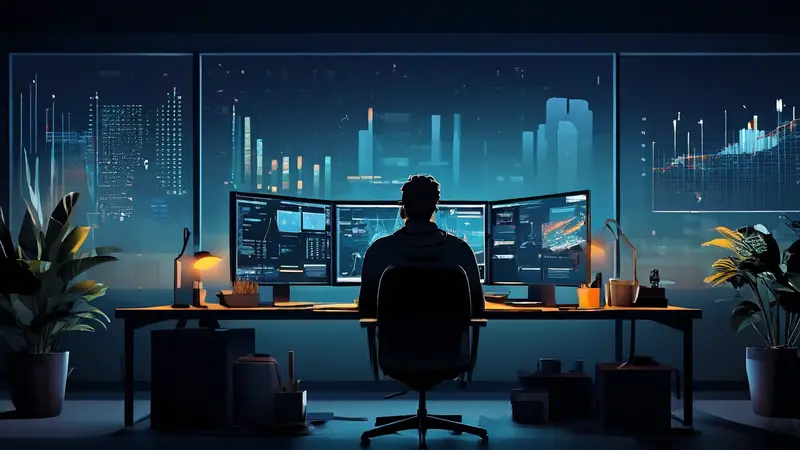Does using a black background when writing code have anything to do with protecting the eyesight of programmers?

A black background is widely recommended in coding, primarily because it reduces eye strain, improves focus, saves battery life, and enhances contrast, thereby improving code readability. Reducing eye fatigue is a core advantage, mainly due to the low light radiation of the black background, which can effectively reduce the risk of eye discomfort and vision loss caused by staring at the screen for long periods of time. In other words, using a black background is indeed inseparable from protecting the programmer's eyesight.
1. Reduce eye fatigue
A black background helps reduce the eye's sensitivity to light by reducing the brightness of the screen. Staring at high-brightness screens for long periods of time can put a strain on your eyes, leading to dryness, fatigue, and even blurred vision. In contrast, a black background, due to its low reflectivity, prevents the eyes from having to adapt to excessive brightness, thereby reducing visual fatigue. In addition, a black background is especially beneficial for programmers working in low-light environments, as it can reduce eye stress caused by the large contrast between the screen and the surrounding environment.
2. Improve focus and concentration
A black background can effectively reduce distractions and help programmers better focus on the code itself. Against a black background, the contrast of text and symbols is greatly improved, making the structures in the programming language clearer and easier to read. This visual effect helps improve coding efficiency and reduces the distraction of frequently looking for blocks of code. At the same time, working in this environment can reduce visual stimulation for programmers who code for a long time, allowing them to stay focused longer.
3. Save battery life
Especially for electronic devices using OLED or AMOLED screens, a black background can significantly reduce the screen's energy consumption. This is because these types of screens actually turn off the lighting of the corresponding pixels when they display black, thus saving power. This is an advantage that cannot be ignored for remote programmers who need to work away from the power supply for a long time or for people who often need to program outside. The saved power can keep the equipment running at critical moments and ensure the continuity of coding work.
4. Enhance contrast and readability
A black background not only reduces strain on the eyes, but also improves the overall readability of the code by enhancing the contrast of text and symbols. In programming, discerning different syntactic elements and logical structures is crucial to writing high-quality code. Higher contrast makes code elements such as keywords, variables, and functions more prominent, reducing the time required to understand and debug the code. In addition, many development environments and text editors allow users to customize color schemes, further enhancing a personalized visual experience, helping to improve programming efficiency and reduce errors.
To sum up, the use of black background in programming is indeed directly related to protecting the eyesight of programmers. It helps protect eyesight and improve coding efficiency by reducing light radiation, improving contrast and reducing visual interference. Although not everyone is suitable or prefers a black background, from a health and productivity perspective, it is undoubtedly worth trying this mode and comparing your personal experience.
Related FAQs:
Q: Does using a black background help protect programmers’ eyesight? Answer: Although a black background will not directly protect the programmer's vision, it can reduce the sensitivity of the eyes to bright light. Compared with a bright white background, a black background reduces the stimulation of light to the eyes and reduces eye fatigue, thereby reducing the possibility of visual fatigue and discomfort.
Q: In addition to a black background, are there any other ways to protect programmers’ vision? Answer: Yes, in addition to using a black background, there are some other methods that can help programmers protect their eyesight. First, maintain good posture and a correct working distance and avoid placing the screen too close or too far away. Secondly, regular breaks and eye-relaxation exercises are also very important. For example, take a regular break for a few minutes every hour and perform some eye-relaxation activities, such as looking away from the screen, closing your eyes and doing some eye massage, etc. Finally, it is also crucial to maintain a good indoor lighting environment. Too weak or too strong light is harmful to the eyes.
Q: How should programmers choose a suitable display to protect their eyesight? Answer: Choosing the right display is very important. First, you should choose a high-quality display and try to avoid low-resolution and flickering screens, as these can adversely affect vision. Secondly, choose a screen size and resolution that suits you. Do not choose a screen that is too large or too small, so as not to cause your eyes to move excessively or focus too much. Finally, adjust the screen brightness and contrast to a comfortable level that suits you. A screen that is too bright or too dark will have a negative impact on your vision.
-
 It's the spooky time of the year, so here are some of the best horror games you can play to give yourself a good scare.
It's the spooky time of the year, so here are some of the best horror games you can play to give yourself a good scare. -

Moon House Room Escape Walkthrough
Solve the Moon House apartment tour puzzle! -

How to Play Dice in Kingdom Come Deliverance 2: All Badges & Scoring Combos
If you're wondering how to play dice in Kingdom Come: Deliverance 2, here's what you need to know about that. -

How to make a car in Build a Car to Kill Zombies
Zombie Stampede!
